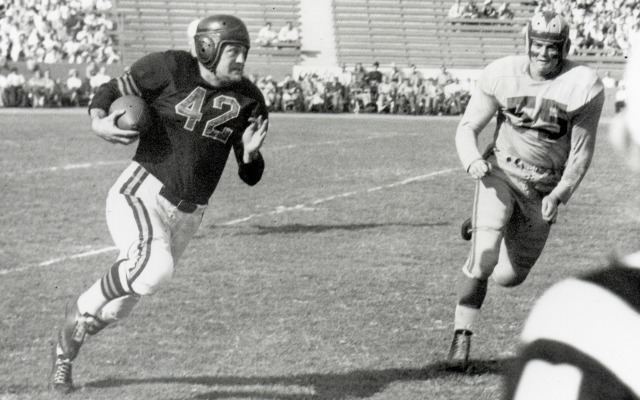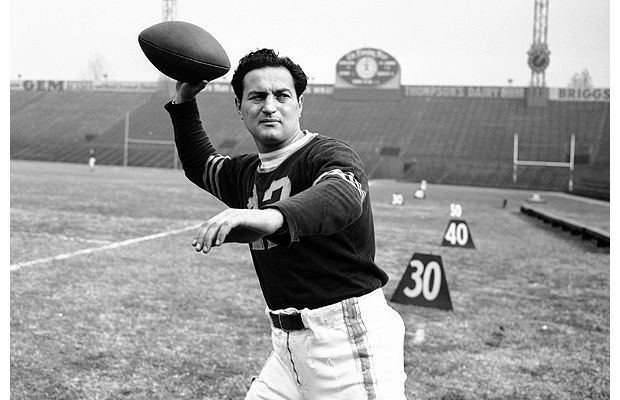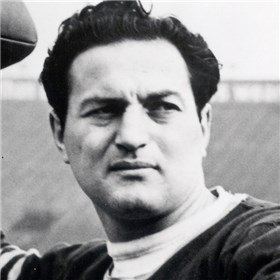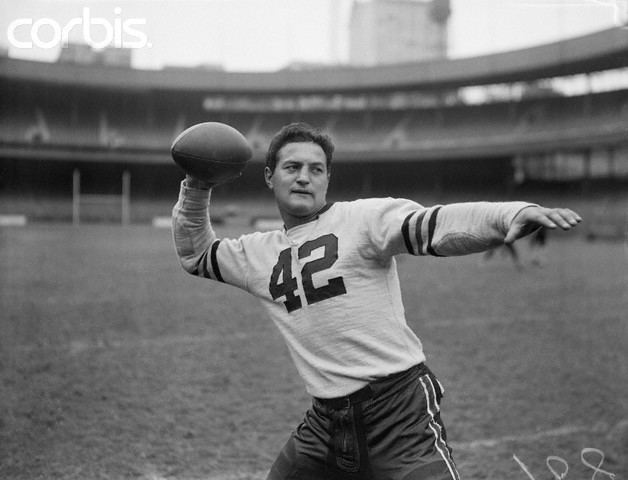Name Sid Luckman Weight 89 kg | Height: 6 ft 0 in (1.83 m) Career end 1950 College: Columbia Position Quarterback | |
 | ||
Date of birth: (1916-11-21)November 21, 1916 Date of death: July 5, 1998(1998-07-05) (aged 81) Similar People | ||
Huge sid luckman 1 1 mailday for the quarterback auto pc
Sidney Luckman (November 21, 1916 – July 5, 1998) was an American football quarterback for the Chicago Bears of the National Football League (NFL) from 1939 through 1950. During his twelve seasons with the Bears he led them to four NFL championships.
Contents
- Huge sid luckman 1 1 mailday for the quarterback auto pc
- Pro Football Championship game 1943
- Early life
- Draft
- T formation
- Service with the Merchant Marine
- Numbers and accomplishments
- Later years
- List of honors
- References

Luckman was the first modern T-formation quarterback and is considered the greatest long range passer of his time. He was named the NFL's Most Valuable Player in 1943, and sports writer Ira Berkow wrote that Luckman was "the first great T-formation quarterback". Following his retirement from playing, Luckman continued his association with football by tutoring college coaches, focusing on the passing aspect of the game.

Luckman was inducted into the Pro Football Hall of Fame in 1965, and in 1988 he was declared a joint winner of the Walter Camp Distinguished American Award.

Pro Football Championship game 1943
Early life

Luckman was born in Brooklyn, New York, to Jewish immigrants from Germany. His father sparked his interest in football at age eight, by giving him a football to play with. He and his parents lived in a residence near Prospect Park and it was here as a youngster that Sid first started throwing the football around.
He played both baseball and football for Erasmus Hall High School, with his football skills impressing recruiters from about 40 colleges. Luckman chose Columbia University after meeting Lions coach Lou Little during a Columbia/Navy game at the university's Baker Field athletic facility. Luckman was not admitted to Columbia College; instead, he attended the New College for the Education of Teachers, an undergraduate school, which was within Teachers College at Columbia. He competed on the football team from 1936 until the New College closed in 1939, when he transferred to Columbia College. Coach Little had a problem of getting good high school athletes because of the entrance requirements at Columbia, and Columbia didn’t have any physical education undergraduate program, and so, when New College was started Lou Little was happy because they had a P. E. Department. In fact, the 1936 varsity football squad had five other New College students, Hubert Schulze, Edward Stanzyk, Oscar Bonom, Harry Ream, and Antoni Mareski.

At Columbia Luckman was a member of the Zeta Beta Tau fraternity. Keen to remain in Columbia to stay close to his family, he took on jobs such as dish-washing, baby-sitting, and messenger delivery around the campus. At Columbia, as a part of the football team, he completed 180 of 376 passes for 2,413 yards and 20 touchdowns and finished third in the 1938 Heisman Trophy voting, behind Davey O'Brien and Marshall Goldberg.
Draft
Hearing of Sid Luckman's exploits as a single-wing tailback at Columbia University, Chicago Bears owner and coach George Halas believed Luckman had the ability to become an effective T-formation quarterback, and traveled to New York to watch him play. Halas then convinced the Pittsburgh Pirates (later the Steelers) to draft Luckman second overall and then trade him to the Bears because he was interested in using Luckman's skills to help him restructure the offensive side of the game. However, despite his successes at Columbia University, Luckman initially declined any further interest in pro football, instead preferring to work for his father-in-law's trucking company. Halas went to work on convincing him otherwise. After gaining an invitation to Luckman's tiny apartment for a dinner which Luckman's wife Estelle prepared, Halas produced a contract for $5,500 ($93,600 today) which Luckman immediately signed. At that time both at the college and pro levels, offenses were a drab scrum of running the ball with only occasional passes. In what was then the predominant single-wing formation, the quarterback was primarily a blocking back and rarely touched the ball. Most passing was done by the tailback, and then usually only on third down with long yardage to go. Halas and his coaches, primarily Clark Shaughnessy, invented a rather complex scheme building on the traditional T-formation, but needed the right quarterback to run it properly.
Upon starting with Halas, Luckman mastered an offense that revolutionized football, and became the basis of most modern professional offenses. Eventually, Luckman tutored college coaches across the Big Ten, Notre Dame and West Point in the intricacies of the passing game.
T-formation
In 1940, during his second season with the Bears, Luckman took over the offense and led the Bears to the title game against Sammy Baugh and the Washington Redskins. The Redskins had beaten the Bears, 7–3, during the regular season. Using the "man-in-motion" innovation to great advantage, the Bears destroyed the Redskins, 73–0, stated to be "the most one-sided game in the history of the sport". Luckman passed only six times, with four completions and 102 yards in the rout.
From 1940 to 1946, the Bears displayed their dominance in the game, playing in five NFL championship games, winning four, and posted a 54–17–3 regular season record. In 1942, the Bears posted a perfect 11–0 record and outscored their opponents, 376–84, however they lost the championship game to the Redskins. Although the T-formation had been used many years before Luckman joined the Chicago Bears, he was central to Chicago's successful use of this style of play because of his game-sense and versatility. Perfecting Halas' complex offensive scheme of fakes, men in motion, and quick hitting runs, Luckman added the dimension of accurate downfield throwing. He was instrumental in his team's record-setting 73–0 win over the Washington Redskins in the 1940 NFL championship game. Sportscaster Jimmy Cannon once said in reference to Luckman's years at Columbia, "You had to be there to realize how great Sid was." Luckman later became a sought-after tutor and instructor for universities wishing to install the T-formation as an offense.
Service with the Merchant Marine
In 1943, as soon as the season had ended, Luckman volunteered as an ensign with the U. S. Merchant Marine. He was stationed stateside and while he could not practice with the team, he did receive permission to play for the Bears on game days during the following seasons. He returned again to the Bears, as a full-time occupation, in 1946 and led them to a fifth NFL championship.
Numbers and accomplishments
During his career, Luckman completed 51.8% of his passes for 14,686 yards and 137 touchdowns with 132 interceptions. He averaged 8.4 yards per attempt, second all-time only to Otto Graham (8.6), and also has a career touchdown rate (percentage of pass attempts that result in touchdowns) of 7.9 percent.
In 1943, Luckman completed 110 of 202 passes for 2194 yards and 28 touchdowns. His 13.9% touchdown rate that year is the best ever in a single-season, while his 10.9 yards per attempt is second all-time. During one game that year, Luckman threw for 443 yards and seven touchdowns, still tied for the most passing touchdowns in one game; it was also the first 400-yard passing game in NFL history. His 28 touchdown passes in 1943 (in only 10 games) was a record that lasted until 1959, a 12-game season.
Luckman led the NFL in yards per attempt an NFL record seven times, including a record five consecutive years from 1939 to 1943, and led the NFL in passing yards three times. Luckman was a five-time All-NFL selection, was named the National Football League's Most Valuable Player Award in 1943, and led the "Monsters of the Midway" to championships in 1940, 1941, 1943, and 1946. Despite the fact that his career ended in 1950, Luckman still owns several Bears' passing records, including:
Later years
After retiring from the NFL, Luckman went to work for Cel-U-Craft, a Chicago-based manufacturer of cellophane products, eventually becoming its president. The company was a part of the Rapid American Corporation of which he also obtained shares. In 1969, RAC was the subject of an IRS investigation over the payment of these shares and dividends, a case that Luckman and his wife appealed.
Luckman's wife, Estelle Morgolin, died of cancer in 1981, and he underwent a triple heart bypass operation the following year. Luckman eventually retired to Aventura, Florida where he died on July 5, 1998 at the age of 81. He is survived by a son, Bob, and two daughters, Gale and Ellen.
List of honors
- Joe F. Carr Trophy – National Football League Most Valuable Player in 1943.
- College Football Hall of Fame in 1960
- Pro Football Hall of Fame in 1965.
- Walter Camp Distinguished American of the Year Award in 1988.
- Columbia University Athletics Hall of Fame in 2006.
